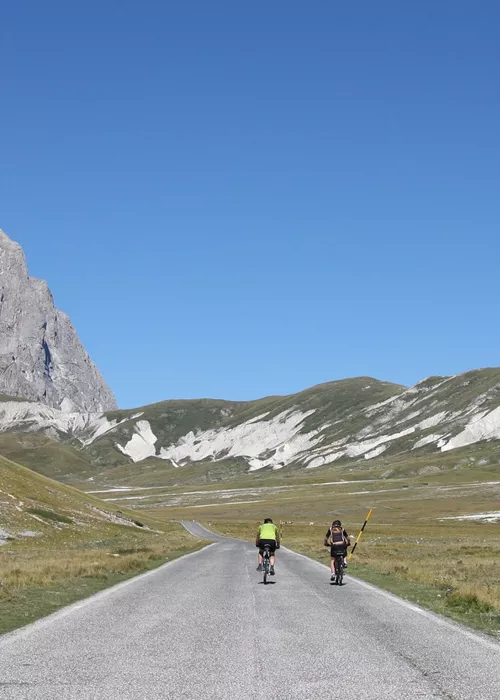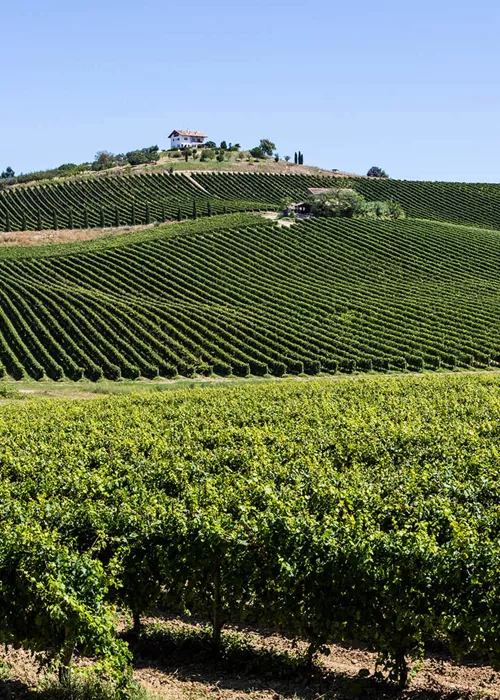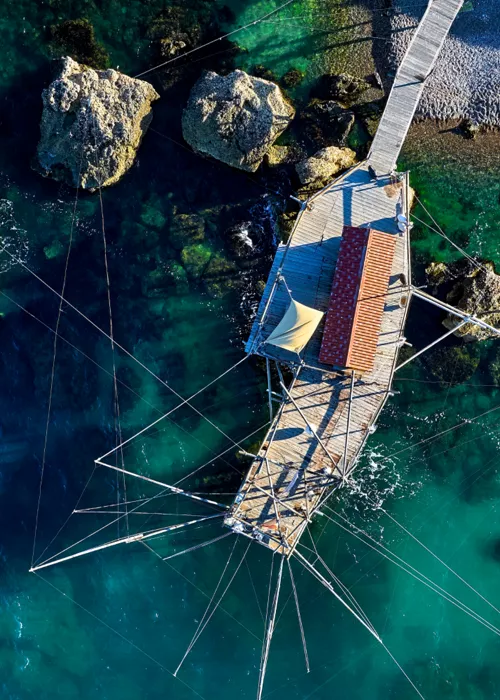Giulianova

Along the Rotta dei Trabocchi, the port of Giulianova welcomes you with a modern facility located in the heart of the city's seafront, not far from the railway station and well connected to the upper part of the city by bus, but also accessible on foot thanks to a paved path. Leaving the port, walk north along the monumental promenade and admire the magnificent Liberty buildings such as Villa Paris-Costantini and Villa Gasbarrini. Stop off at the charming Kursaal, another elegant historic building built in 1913 as a naval club and completed sixteen years later in Liberty style (today a venue for cultural initiatives), and at the Civic Museum complex, scattered throughout the historic centre, which includes the Vincenzo Bindi House Museum, the Raffaello Pagliaccetti Sculpture Hall, the Torrione La Rocca Archaeological Museum and the De Bartolomei Chapel. Giulianova, with its Roman roots, is a town rich in history and one of the seven pearls or seven sisters of the Teramo Garden Coast. Enter the upper town and admire the Duomo di San Flaviano, with its majestic architecture and evocative atmosphere that will envelop you. Built at the turn of the 15th and 16th centuries, it has a particularly evocative interior, thanks to its clean, classical lines and the well of light coming from the lantern.
Not to be missed are the Torrione Il Bianco, the most imposing remnant of the ancient city walls, and the Sanctuary of the Madonna dello Splendore, a place of intense devotion where every year the people of Giulianova celebrate the apparition of the Virgin Mary which, according to tradition, took place in 1557. The panoramic belvedere offers a breathtaking view of the lower town and houses the church of Santa Maria a Mare, the oldest in Giulianova, dating back to the 12th century. Its terracotta façade is adorned with a magnificent 14th century portal decorated with eighteen finely engraved panels. These architectural and historical treasures make the town of Giulianova an unmissable destination.
Roseto degli Abruzzi

On the route between Giulianova and Roseto degli Abruzzi, the Borsacchio Nature Reserve is an essential stop for nature lovers. This protected area of unspoilt beauty, characterised by dunes and Mediterranean scrub, is the natural habitat of rare bird species. An enchanting paradise also crossed by an unpaved section of the bike path that connects the seaside resorts of Abruzzo, with a hilly section almost entirely covered by olive groves, vineyards and wheat fields, offering evocative landscapes. The reserve's curiosities include a centuries-old olive grove and a historic wine cellar, still in use, which houses one of the largest oak barrels in Europe. The journey then continues to another popular seaside resort on Teramo's Costa Giardino: Roseto degli Abruzzi, known as the Lido delle Rose (Lido of Roses) for the multicoloured rose bushes and oleanders that once adorned the streets of its seafront. This popular tourist resort on the Abruzzo Riviera is particularly popular with families thanks to its wide, fine sandy beaches, which are awarded the Blue Flag and the Green Flag every year, the latter being awarded by the Paediatricians' Association for its child-friendly services. The area of Roseto degli Abruzzi has an extraordinary natural beauty. In addition to the sea, the hills offer an equally fascinating experience and allow you to discover an unusual side of the city. Founded 135 years ago as an offshoot of the ancient mediaeval village of Montepagano , now part of the Association of Authentic Villages of Italy, Roseto degli Abruzzi offers a breathtaking panorama that stretches from the Adriatic Sea to the peaks of the Gran Sasso d'Italia.
The Abbeys of the Vomano Valley

Heading inland along the SS 150 road, known as the Via delle Abbazie, it is possible to admire authentic masterpieces of Abruzzo religious art, which are scattered throughout the Vomano Valley. The first stop is the Abbey of Santa Maria di Propezzano, in the municipality of Morro d'Oro. Surrounded by vineyards, with a private wine cellar in the cloister (not always accessible), the abbey is perfectly preserved in its Benedictine structure. The façade is in three parts of different heights, with a central body surmounted by a three-arched portico that preserves the remains of 15th century frescoes, which are also present inside. On the right is the Holy Door, which is only open on 10 May and Ascension Day. A few kilometres further on, in Guardia Vomano, in the municipality of Notaresco, is the 11th-century church of San Clemente al Vomano. The three-nave interior leads to the presbytery, where you can admire a precious Norman ciborium, finely carved by Roberto di Ruggero in the 12th century, the oldest in Abruzzo. Finally, a short detour to the village of Canzano leads to the Abbey of SS. Salvatore, dating back to the 12th century. The Benedictine structure dates back to the Romanesque period, but the abbey is undoubtedly of much older origin. The interior has three naves with no transept and ends in a large apse. The church is famous for its numerous frescoes, including the 14th-century paintings attributed to the Maestro di Offida, located in the subarches of the naves, depicting the Presentation in the Temple, the Last Supper, the Annunciation and the Crucifixion.
Teramo

Back on the main road, we reach Teramo, the ancient Roman Interamnia and provincial capital, rich in history and culinary traditions. The most important of these are the virtues, one of the most complex dishes of Abruzzo gastronomy, much more than a simple minestrone, celebrated every year on May 1st in the restaurants and homes of the city. Visiting Teramo begins with its most iconic symbol: the majestic Cathedral of Santa Maria Assunta, built in 1158. Inside, the high altar is adorned with a magnificent silver antependium by Nicola da Guardiagrele, the most important goldsmith in Abruzzo in the 15th century, and the equally splendid 15th-century polyptych of St Augustine by the Venetian Jacobello del Fiore. A short distance away is the Roman part of the city, with the remains of the theatre - currently the focus of a major restoration project - and the amphitheatre, as well as numerous other archaeological finds. Not far from the town centre is the eclectic Castello Della Monica, which is not currently open to the public, but is impressive for its original forms. The nearby Pinacoteca Civica, which is free to enter, contains 15th century altarpieces, paintings from the 17th and 18th century Neapolitan school and 19th century Abruzzo works such as paintings by Pasquale Celommi, Gennaro Della Monica, Giuseppe Bonolis and sculptures by Raffaele Pagliaccetti.
Continuing towards the slopes of the Monti della Laga, it is worth stopping at Campli , one of the most beautiful villages in Italy. Here you can visit the archaeological site of the necropolis of Campovalano, with over 600 tombs dating from the Bronze Age to the Roman period. The most important finds are kept in the National Archaeological Museum, inaugurated in 1988 in the 14th century convent of San Francesco. In addition, the faithful can climb the twenty-eight hard oak steps of the Sacred Staircase on their knees and obtain a plenary indulgence. Before setting off for Civitella del Tronto, you should not miss a sandwich with the tasty Porchetta Italica di Campli, an Italian roasted pork delicacy that has been on the tables of princes, bishops, nobles and commoners since ancient times, and that has been celebrated since 1964 at the oldest gastronomic festival in Abruzzo, held the week after Ferragosto (Mid-August).
Civitella del Tronto

Finally, we arrive at the last stop on this Teramo itinerary: Civitella del Tronto, the 'civitas fidelissima', dominated by the majestic Bourbon fortress. This masterpiece of military engineering is the second largest in Europe, covering an area of over 25,000 square metres. The fortress houses a historical museum with a rich collection of ancient weapons, maps and documents. Its three parade grounds, mighty bastions and patrol trenches offer spectacular views from the Gran Sasso d'Italia to the Adriatic Sea. The cisterns, the remains of the governor's palace, the church of San Giacomo and the soldiers' barracks are all worth visiting inside the fortress. This was the last Bourbon bastion to surrender to the Piedmontese army after the unification of Italy. A dense network of alleys and narrow streets, including the "Ruetta d'Italia" - the narrowest street - and stone houses with masterfully carved portals, joined together by common walls, are all evidence of why Civitella del Tronto is listed as one of the most beautiful villages in Italy. To fully understand its history, we recommend a visit to the NINA Museum, created in memory of Gaetana Graziani Scesi, which, thanks to numerous donations, houses a collection of more than 3,000 pieces representing all the decorative arts. From Civitella del Tronto it is also possible to reach, within a few kilometres, the natural wonders of the Monti della Laga, including the Salinello Gorge, one of the most spectacular valleys in the Apennines. Along picturesque paths you can reach the Sant'Angelo cave, the ruins of Castel Manfrino and the Salinello waterfall, also known as the Cascata del Caccamo, where our itinerary ends.














